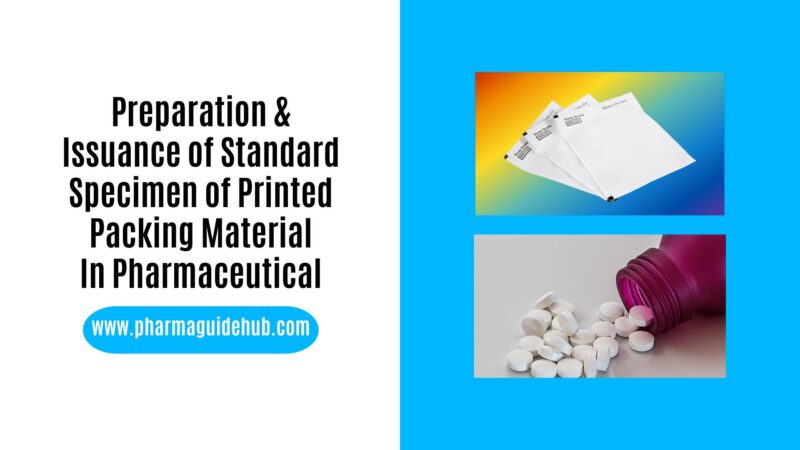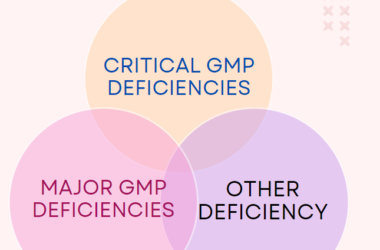OBJECTIVE:
To lay down a procedure for preparation and issuance of standard specimen of printed packing material.
- SCOPE:
This SOP is applicable for preparation and issuance of standard specimen of printed packing material at {Company Name} {Company Location}.
- RESPONSIBILITY:
Marketing Head, Purchase Department Head/Designee, QC Executive/Designee
QA Executive / Designee.
- ACCOUNTABILITY:
QA Head & QC Head
- PROCEDURE:
- Purchase Department shall arrange printed specimen samples of shade cards which shall consists of one light, standard and dark shade from printer.
- Purchase department shall be responsible to send the shade card to QA department.
- QA officer/Executive shall check the standard specimen of shade card against approved artwork.
- Final approval shall be given by QA department.
- After the final approval of shade card from QA department. QC shall prepare a record for shade cards as per current artwork.
- QA department shall distribute the one-one copy of shade cards to QC, purchase department & marketing department.
- After getting the approval from all departments, QA shall send the approved shade card to vendor for further reference and consignment of printing.
- Approved shade card shall be valid for 2 years and shall be revised after 2 years or as whenever required.
- QC, Purchase Department & Marketing department shall handover the shade cards to QA department, same shall be destroyed by QA Officer/Executive as per SOP .
REFERENCES:
Not Applicable
- ANNEXURES:
Not Applicable
ENCLOSURES: SOP Training Record.
- DISTRIBUTION:
| Controlled Copy No. 01 | : | Head Quality Assurance |
| Controlled Copy No. 02 | : | Head Quality Control Department |
| Controlled Copy No. 03 | : | Head Purchase Department |
| Controlled Copy No. 04 | : | Head Marketing Department |
| Master Copy | : | Quality Assurance Department |
ABBREVIATIONS:
| QA | : | Quality Assurance |
| SOP | : | Standard Operating Procedure |
| PD | : | Purchase Department |
| QC | : | Quality Control |
REVISION HISTORY:
CHANGE HISTORY LOG
| Revision No. | Details of Changes | Reason for Change | Effective Date |
| 00 | New SOP | Not Applicable | To be written manual. |
Frequently Asked Question ?
Q1: What is the purpose of preparing and issuing standard specimens of printed packing materials in the pharmaceutical industry?
A1: The purpose of preparing and issuing standard specimens of printed packing materials in the pharmaceutical industry is to establish a reference for quality control and ensure consistency in packaging materials. Standard specimens serve as a benchmark to maintain uniformity in printing, dimensions, and other critical parameters, thereby ensuring the integrity and compliance of pharmaceutical packaging.
Q2: How is the preparation of standard specimens regulated in the pharmaceutical industry?
A2: The preparation of standard specimens for printed packing materials in the pharmaceutical industry is regulated by relevant regulatory authorities, such as the Food and Drug Administration (FDA) or equivalent agencies in different countries. These regulations provide guidelines on the creation, approval, and maintenance of standard specimens to meet quality and safety standards.
Q3: What are the key considerations in preparing standard specimens for printed packing materials?
A3: Key considerations in preparing standard specimens include accurate representation of the final product, adherence to regulatory requirements, inclusion of critical information (e.g., product name, dosage, and usage instructions), and consistency in design, color, and printing quality.
Q4: How often should standard specimens be reviewed and updated in the pharmaceutical industry?
A4: Standard specimens should be reviewed and updated regularly, especially when there are changes in regulations, product specifications, or printing technologies. It is crucial to ensure that standard specimens accurately reflect the current packaging requirements and comply with the latest industry standards.
Q5: What steps are involved in the issuance of standard specimens in the pharmaceutical industry?
A5: The issuance of standard specimens involves approval from relevant stakeholders, including quality assurance, regulatory affairs, and production departments. Once approved, the standard specimens are distributed to all relevant parties, such as printing vendors, to serve as a guide for producing consistent packaging materials.
Q6: How can deviations from standard specimens be managed?
A6: Deviations from standard specimens should be documented, investigated, and addressed through a controlled change management process. Any changes to the standard specimens should be properly validated and communicated to ensure that the quality and regulatory requirements are maintained.
Q7: What role does quality assurance play in the preparation and issuance of standard specimens?
A7: Quality assurance is essential in the preparation and issuance of standard specimens to ensure that they accurately represent the intended packaging. Quality control processes help identify and rectify any discrepancies, ensuring that the printed packing materials meet the required standards for safety, efficacy, and compliance.
Q8: How do pharmaceutical companies ensure the security and confidentiality of standard specimens?
A8: Pharmaceutical companies implement strict access controls and confidentiality measures to protect standard specimens from unauthorized access or use. Limited access is granted to individuals involved in the design, approval, and production processes, and confidentiality agreements may be required.
Q9: How can digital technologies be integrated into the preparation and issuance of standard specimens?
A9: Digital technologies, such as electronic documentation systems and digital approval workflows, can streamline the preparation and issuance of standard specimens. This facilitates real-time collaboration, version control, and efficient distribution of standard specimens to relevant stakeholders.
Q10: What are the consequences of non-compliance with standard specimens in pharmaceutical packaging?
A10: Non-compliance with standard specimens in pharmaceutical packaging can lead to regulatory issues, product recalls, and compromised product integrity. It is crucial for pharmaceutical companies to adhere to established standards to ensure the safety, efficacy, and quality of their products.




